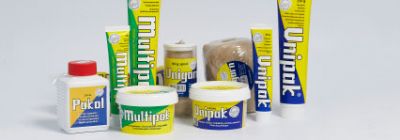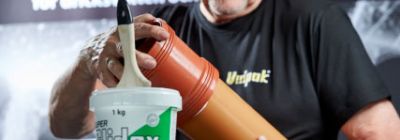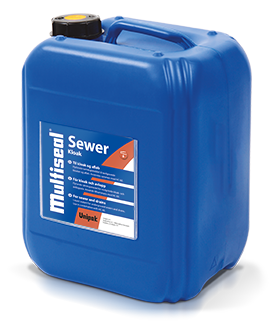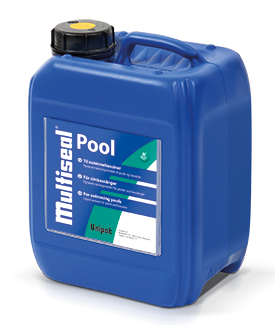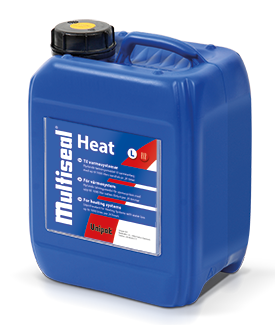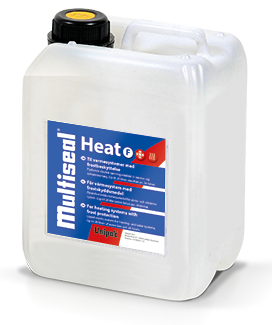GAS SYSTEMS
PRODUCT DESCRIPTION:
MULTISEAL is a liquid sealant which is added directly to the water in a closed heating system for sealing off hidden leaks. MULTISEAL is available in different product varieties attuned to the environment where a leak has to be sealed. MULTISEAL GAS 2000 is dedicated for leaking gas systems with threaded joints.
TECHNICAL PROPERTIES:
MULTISEAL sealing systems are based on dispersed crystalline minerals. MULTISEAL GAS 2000 is pumped into the in your gas tubes and leaks are sealed here during the process described hereafter days "by itself" through sediments of silicate in the leaks. It is therefore not necessary to know exactly where any leakage is to seal it with MULTISEAL. MULTISEAL 2000 is used undiluted and may be reused for several sealing jobs.
DIRECTIONS:
Leak size is determined:
Multiseal Gas 2000 is designed to seal gas leaks between 1liter and 5 liters per. hours.
The gas pipeline is tested:
The gas meter and all gas appliances are removed. At all tube end points ball valves / shut-off valves are mounted. Also plugs in all disused pipeline but still under gas pressure must be removed and replaced with shut-off valves. It is important that all valves are fitted tightly.
Leak size retested:
Once again verified the leak size, partly to ensure that stop valves are tightly fitted and to ascertain that it was not in some of the disassembled gas units that the leak was located.
The gas pipeline is cleaned:
In the pipeline lowest lying point - where the gas meter was connected – a fibre reinforced connected hose that ends in a dust filter has to be mounted – preferably with the dust filter in the open. The Gas pipeline now has to be blown through with nitrogen or compressed air being blown into the pipe system from all ends where the shutoff valves are installed. The blowing continues until no more dust is blown into the dust filter.
Filling the gas plant with Multiseal Gas 2000
The gas pipeline is now filled slowly from below via the lower shot-off valve. For filling use a diaphragm pump that runs on either compressed air or nitrogen. Make sure there is plenty of Multiseal Gas 2000.
Gas plant is now flooded from below through venting the shot-off valves – starting with the shutoff valve at the bottom - and nearest to the filling the spot.
After shut-off valves are vented properly and it thus is certain that there is Multiseal Gas 2000 in all corners of the pipe system, the now filled gas plant is put under 4 bar pressure plus a bar for every 10 meters there is added to the installation in height. In this way Multiseal Gas 2000 is pressed into the leaky threaded joints. The pressure of fluid is maintained for 30 min.
To be able to use both diaphragm pump and the filling equipment on other pipelines during those 30 minutes it is permissible to place a pressure buffer in the top of the pipeline at 1 to 2 L (max. 4 bar).
Emptying the gas plant
Diaphragm pump is diverted from pump to suck. The canister for the collection of residue Multiseal Gas 2000 is located at the plant bottom point where the filling was also happening. The pressure is gently taken of the facility through venting of the top shut-off valve. Hereafter the valves are vented valves downwards until all Multiseal Gas 2000 has been sucked out of gas plant again.
Squeezing of excess fluid
When it is not possible to suck out further Multiseal Gas 2000 out of the gas pipelines, foam rubber balls at least 10% larger in diameter than pipe dimensions in the system is filled in at all shut-off valves. The foam balls are now pressed / pushed through the system with nitrogen or compressed air and collected at the plant lowest point where the residue cannister is still connected. The foam balls push the last remaining Sealing fluid ahead and ensure that the plant is completely emptied. Foam rubber balls must be pressed through the gas plant at least twice, maybe more, depending on how much liquid they take out.
Multiseal Gas 2000 can be reused.
The Multiseal Gas 2000 that has been used in the system is collected, purified through a sieve and can then be reused for sealing purposes again.
Drying
When the process with the foam balls is finished the gas plant has to be dried using a suitable blower. Shut-off valves are replaced with ventilation tubes whose ends are all put into “vent bins” which collects any excess fluid .The actual blowing device must be free so there is nothing that prevents the flow of air to the blower. The blowing process must continue for at last 1 hour at a plant with 1"pipe and 25meter length. If the pipeline has larger dimensions the drying process has to be correspondingly prolonged. Even after drying remains Multiseal Gas 2000 "viscous" and sticky.
Commissioning
After drying, the plant is ready for pressure testing, and all the removed parts are reinstalled and the plant is ready for use.
CLEANING:
By skin contact, wash off skin with plenty of soap and water. Wear safety goggles when working with MULTISEAL! By eye contact away rinse immediately with plenty of water. Spills on clothing are removed easily at normal temperature machine wash. NOTE! To avoid falls and silicate sediments any spill of MULTISEAL has to be washed of immeditaly.
|
PACKAGING |
||||||
|
Product |
Packaging |
Item no. |
VVS-no. |
RSK-no. |
NRF-no. |
LVI-koodi |
|
MULTISEAL GAS 2000. |
10 Lcan |
8024100 |
251207110 |
4054439 |
9815799 |
3265253 |
